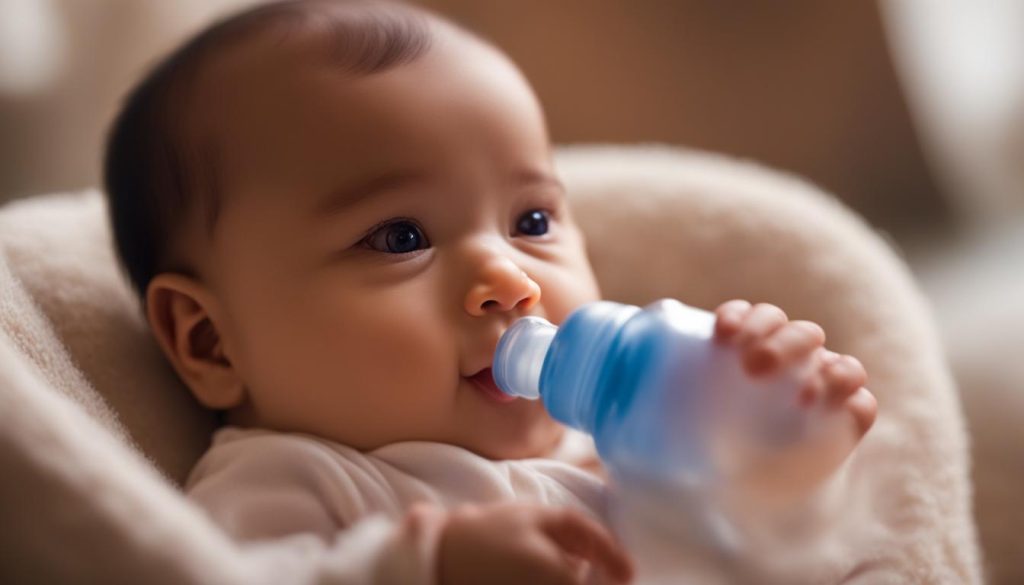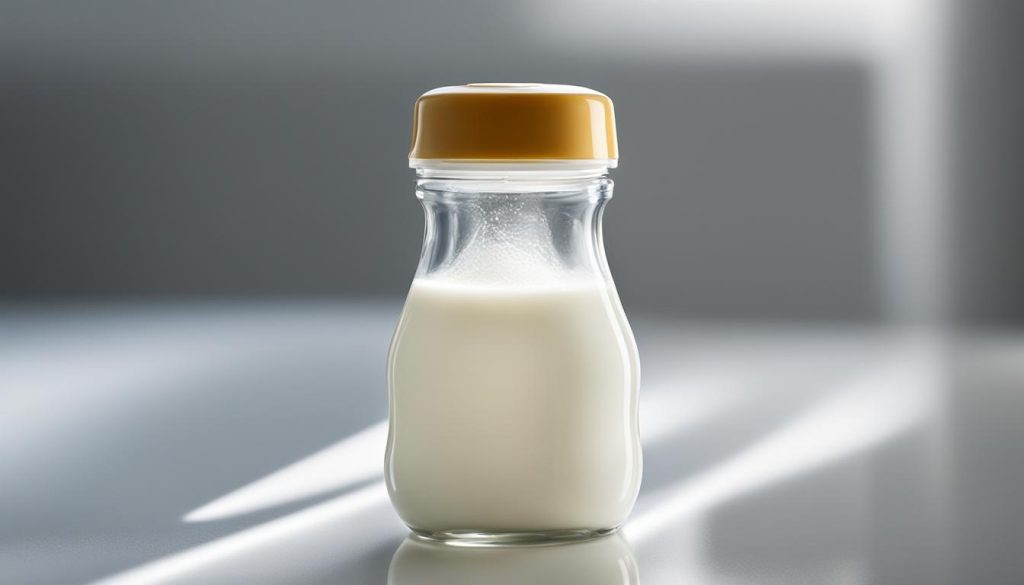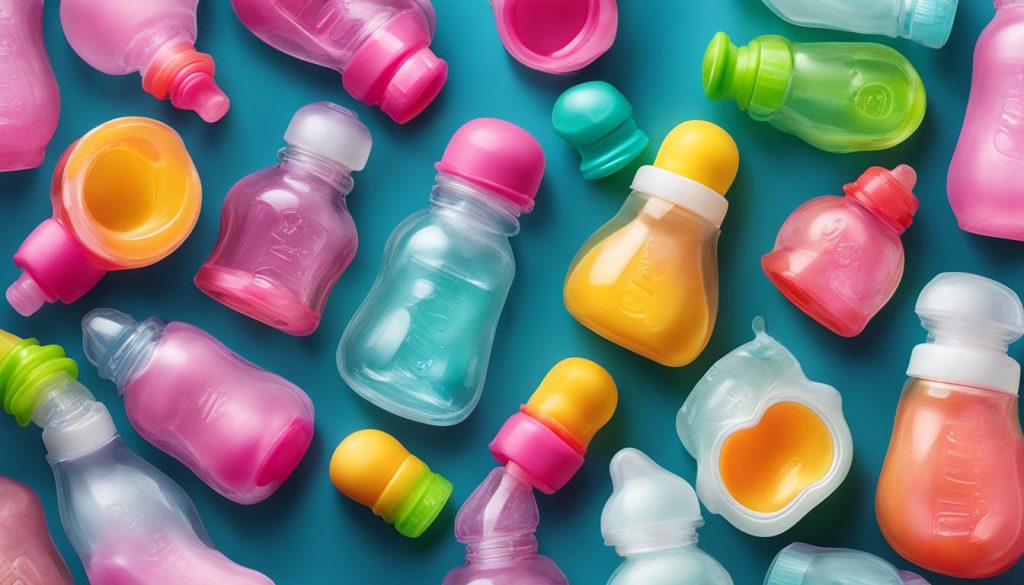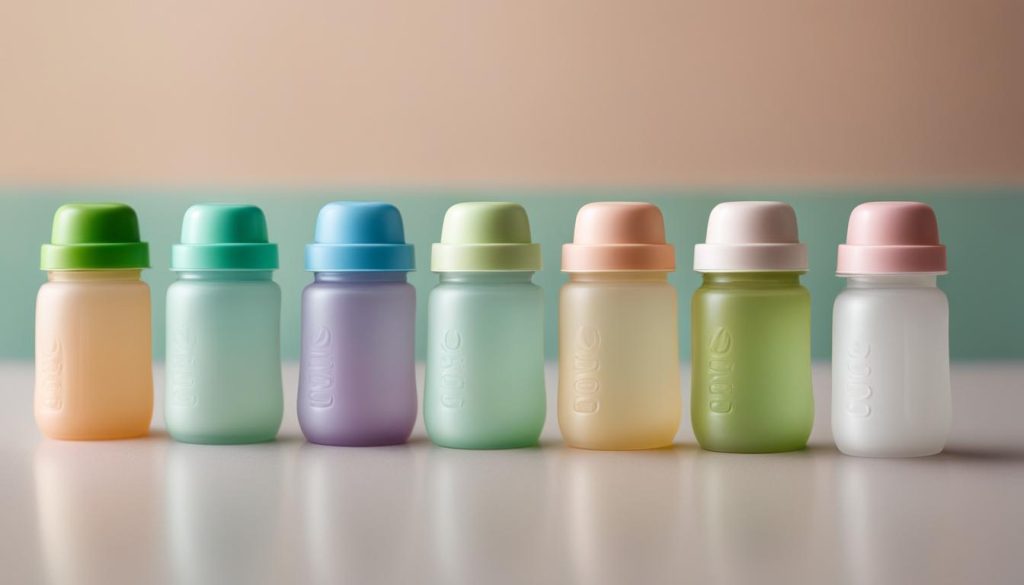When it comes to feeding a 6-month-old baby, choosing the right bottle is essential for their growth and development. As a professional journalist, I understand the importance of finding the best bottle that meets the needs of both the baby and the parent.
As a copywriting expert, I have conducted extensive research to help you find the top-rated bottle for your 6-month-old. From my findings, I will recommend the best baby bottle that will ensure your little one receives the nourishment they need.
Before diving into the details, let’s understand why finding the right bottle is crucial for your baby’s feeding journey. By exploring the benefits of breastfeeding, comparing different types of baby bottles, and understanding the importance of proper bottle maintenance, you can make an informed decision that supports your baby’s growth and development.
Types of Baby Bottles: Choosing the Right One
When it comes to selecting a bottle for your 6 month old, it’s important to consider the different types of baby bottles available on the market. Each type has its own unique features and benefits, making it essential to choose the one that best suits your baby’s needs and preferences.
Glass baby bottles are a popular choice among parents due to their durability and chemical-free composition. These bottles are easy to clean and sterilize, providing a safe and healthy option for feeding your baby.
Plastic baby bottles are lightweight and shatterproof, making them convenient for on-the-go parents. It’s crucial to choose bottles that are free from harmful chemicals like BPA, ensuring your baby’s well-being.
Silicone baby bottles are another option to consider. These bottles are soft and flexible, making them easy for babies to grasp. However, they may be more prone to leakage, so it’s essential to choose a high-quality silicone bottle to prevent any spills or messes.
When selecting a baby bottle, it’s important to assess factors such as durability, ease of cleaning, and your baby’s own preferences. By considering these different types of baby bottles, you can make an informed decision and provide your 6 month old with the best bottle for their growth and development needs.
| Type of Baby Bottle | Features | Advantages |
|---|---|---|
| Glass Baby Bottles | Durable, chemical-free | Easy to clean and sterilize |
| Plastic Baby Bottles | Lightweight, shatterproof | Convenient for travel |
| Silicone Baby Bottles | Soft, flexible | Easy for babies to grasp |
“Choosing the right baby bottle is crucial for providing your 6 month old with a comfortable and enjoyable feeding experience.” – Pediatric Nutritionist
Factors to Consider
- Durability: Look for bottles that can withstand regular use and cleaning.
- Cleaning: Consider how easy it is to clean and sterilize the bottle.
- Baby’s Preference: Pay attention to your baby’s reaction to different bottle materials and nipple shapes.
Remember, the type of bottle you choose can impact your baby’s feeding experience, so take your time to research and find the best option that suits both you and your baby’s needs.
Importance of Infant Feeding: Supporting Growth and Development
Infant feeding plays a crucial role in supporting a baby’s growth and development. Whether through breastfeeding or formula feeding, providing proper nutrition is essential for a baby’s overall health and well-being. The benefits of breastfeeding are well-documented and include providing the ideal nutrition for the baby, boosting the baby’s immune system, and promoting bonding between the baby and the mother. Breast milk is specifically tailored to meet the baby’s nutritional needs and contains antibodies that help protect against infections and diseases.
While breastfeeding is recommended whenever possible, formula feeding can also provide the necessary nutrition for a baby’s growth. Formula is designed to mimic the composition of breast milk and is a safe and nutritious alternative for babies who are unable to breastfeed. It is important to choose a formula that is appropriate for the baby’s age and follow the recommended guidelines for preparation and feeding.
Monitoring feeding milestones is another important aspect of infant feeding. As babies grow, they transition from exclusive breastfeeding or formula feeding to introducing solid foods. These milestones are important indicators of a baby’s readiness for new foods and help ensure they are receiving the right balance of nutrients. Introducing solids should be done gradually and in consultation with a pediatrician or healthcare provider.
Overall, infant feeding is a crucial aspect of nurturing a baby’s growth and development. Whether breastfeeding or formula feeding, providing proper nutrition and monitoring feeding milestones are essential for supporting a baby’s overall health and well-being.
Table: Benefits of Breastfeeding vs Formula Feeding
| Benefits of Breastfeeding | Benefits of Formula Feeding | |
|---|---|---|
| Nutrition | Provides ideal nutrition for the baby, tailored to their needs. | Provides a safe and nutritious alternative when breastfeeding is not possible. |
| Immune System | Boosts the baby’s immune system and helps protect against infections and diseases. | Formula is designed to mimic the composition of breast milk and contains necessary nutrients for growth. |
| Bonding | Promotes bonding between the baby and the mother. | Allows for bonding between the caregiver and the baby during feeding. |
| Convenience | Always available and at the right temperature. | Offers flexibility and convenience for parents. |
| Accessibility | Free and readily available. | Easily accessible and can be purchased in various forms. |
Comparing Nipple Types: Finding the Right Fit
When it comes to choosing the right bottle for your 6-month-old, it’s important to consider the type of nipple used. Nipples come in different flow rates, including slow flow, medium flow, and fast flow. The flow rate determines how quickly milk or formula is released from the bottle. Finding the right nipple for your baby can help ensure a comfortable and efficient feeding experience.
The slow flow nipple is typically recommended for newborns and young infants who are still developing their sucking abilities. This nipple allows for a slower, controlled flow of milk, similar to breastfeeding. It helps prevent your baby from gulping or choking during feedings. Slow flow nipples are designed to mimic the natural flow of breast milk and encourage proper latch and suckling.
As your baby grows and becomes proficient in feeding, you may consider transitioning to a medium flow or fast flow nipple. Medium flow nipples are suitable for older infants who have developed stronger sucking abilities. They allow for a slightly faster flow of milk, accommodating the baby’s increased feeding pace. Fast flow nipples, on the other hand, are designed for older babies who can handle a faster milk flow. These nipples are ideal for babies who finish their bottles quickly or show signs of frustration with slower flow nipples.
| Nipple Type | Flow Rate | Recommended Age |
|---|---|---|
| Slow flow nipple | Slower flow | Newborns and young infants |
| Medium flow nipple | Slightly faster flow | Older infants with stronger sucking abilities |
| Fast flow nipple | Faster flow | Older babies who can handle a faster milk flow |
It’s important to choose a nipple that matches your baby’s feeding abilities and preferences. If your baby seems to be struggling with the flow rate, pay attention to their cues. If they are taking longer to finish a bottle or displaying signs of frustration, it may be time to try a different nipple. Remember, every baby is different, and what works for one may not work for another. Don’t hesitate to experiment with different nipple types to find the one that best suits your baby’s feeding needs.
Bottle Maintenance and Sterilization: Tips for New Parents
Proper bottle maintenance and sterilization are crucial for ensuring your baby’s health and well-being. By following a few simple steps, you can keep your baby’s bottles clean and safe for their use.
Table: Bottle Maintenance and Sterilization Checklist
| Step | Description |
|---|---|
| Step 1 | Wash bottles with warm soapy water after each use. |
| Step 2 | Rinse bottles thoroughly to remove any soap residue. |
| Step 3 | Sterilize bottles before their first use and periodically thereafter. |
| Step 4 | Choose a sterilization method: boiling in water or using a sterilizing solution. |
| Step 5 | Follow the manufacturer’s guidelines for sterilization. |
| Step 6 | Inspect bottles regularly for any signs of wear or damage. |
When washing bottles, use warm soapy water and a bottle brush to clean all the nooks and crannies. Pay special attention to the nipple and collar, as milk residue can accumulate there. Rinse the bottles thoroughly to remove any soap residue, as it can upset your baby’s stomach if ingested. Sterilize the bottles before their first use by boiling them in water for at least five minutes or using a sterilizing solution recommended by the manufacturer.
It is important to follow the manufacturer’s guidelines for sterilization to ensure effective sterilization and maintain the bottle’s integrity. Inspect the bottles regularly for any signs of wear or damage, such as cracks or scratches, as these can harbor bacteria and compromise the bottle’s safety. If you notice any damage, replace the bottle immediately.
By maintaining a routine for bottle cleaning and sterilization, you can provide a safe and hygienic feeding experience for your baby. Remember to wash bottles after each use, sterilize them regularly, and inspect them for any signs of wear. With these simple steps, you can ensure that your baby’s bottles are clean and ready for use.
Expert Advice: Nurturing Your Baby’s Feeding Journey
When it comes to ensuring the best feeding experience for your baby, seeking expert advice can make a significant difference. Experts such as lactation consultants and pediatricians offer valuable insights and guidance on various aspects of feeding, from introducing a bottle to addressing feeding challenges. Their expertise can help you navigate the complexities of feeding and ensure that your baby’s needs are met.
One key area where expert advice can be particularly beneficial is in introducing a bottle to a breastfed baby. Lactation consultants can provide tips and strategies that promote a smooth transition from breastfeeding to bottle feeding, while maintaining a secure latch and comfortable feeding experience for your little one.
Breastfeeding mothers can also benefit from expert support in managing common challenges they may encounter. Lactation consultants can offer advice on maintaining milk supply, alleviating discomfort, and troubleshooting issues such as nipple confusion or low milk production. Their guidance can provide reassurance and confidence to breastfeeding mothers, ensuring a positive and fulfilling breastfeeding experience for both mother and baby.
Additionally, experts can help address feeding challenges that may arise throughout your baby’s journey. Whether it’s concerns about feeding positioning, slow weight gain, or difficulties transitioning to solid foods, consulting with a pediatrician or lactation consultant can provide invaluable guidance and solutions tailored to your baby’s unique needs.
Tips for Introducing a Bottle:
- Choose a calm and relaxed time to introduce the bottle when your baby is not overly hungry or tired.
- Have someone other than the primary caregiver offer the bottle to promote acceptance and reduce association with breastfeeding.
- Use a bottle nipple that mimics the shape and feel of the breast to encourage your baby to latch on and feed comfortably.
- Practice paced bottle feeding, allowing your baby to control the flow of milk and take breaks when needed.
“Seeking expert advice is essential for nurturing your baby’s feeding journey and ensuring that both you and your little one have a positive and fulfilling experience.” – Dr. Emily Carter, Pediatrician
Remember, every baby is unique, and their feeding journey may present individual challenges. Seeking expert advice can provide you with the knowledge and support needed to overcome these hurdles and provide the best possible feeding experience for your baby.
| Expert Advice for Feeding Babies | Tips for Introducing Bottle | Breastfeeding Support | Feeding Challenges |
|---|---|---|---|
| Consult lactation consultants and pediatricians for guidance. | Choose a calm time, have someone else offer the bottle, use a nipple that mimics the breast, practice paced feeding. | Expert support for maintaining milk supply, addressing common breastfeeding challenges. | Consult experts for guidance on feeding difficulties and transitions. |
Top Picks for Bottle Feeding: Best Options for 6 Month Olds
When it comes to choosing the best bottle for a 6 month old, there are several top-rated options that I would recommend. These bottles have been highly praised by parents and experts alike for their quality and functionality.
One of the top picks for bottle feeding a 6 month old is Dr. Brown’s. Their bottles feature an innovative vent system that helps reduce colic, spit-up, and gas. The wide nipple design mimics the feel and flow of breastfeeding, making it an excellent choice for babies transitioning from the breast to the bottle.
Another highly recommended brand is Philips Avent. Their bottles are known for their anti-colic properties and easy-to-hold shape. The nipples are designed to promote a natural latch, ensuring a comfortable feeding experience for your baby.
If you’re looking for a bottle that closely resembles breastfeeding, Tommee Tippee is a great option. Their bottles feature a unique, breast-like nipple shape that encourages a proper latch and allows for a smooth transition between breast and bottle feeding.
Last but not least, Comotomo bottles are a popular choice among parents. Made from soft, squeezable silicone, these bottles are easy for babies to grip and mimic the natural feel of breastfeeding. The wide-neck design also makes them a breeze to clean.
When choosing the best bottle for your 6 month old, consider factors such as your baby’s feeding needs, nipple shape preferences, and ease of cleaning. With these top picks, you can provide your baby with a comfortable and efficient feeding experience while supporting their growth and development.
FAQ
When is the best time to introduce a bottle to a 6 month old?
According to La Leche League’s The Womanly Art of Breastfeeding manual, it is best to wait until the baby is at least three to four weeks old and breastfeeding well before introducing a bottle. By 6 months, babies are already eating other foods and drinking water, so they may not need a bottle anymore.
What should I do if my baby is unable to breastfeed?
If a baby is unable to breastfeed, it is important to start expressing milk early and often to protect the milk supply and ensure the baby is safely fed. Seeking guidance from a lactation consultant or pediatrician can provide support and advice in this situation.
How can I introduce a bottle to a breastfed baby?
There are various strategies for introducing a bottle to a breastfed baby, such as choosing a time when the baby is happy and relaxed, having someone else offer the bottle, and using a teat that encourages the baby to open their mouth wide. Paced bottle feeding, which mimics breastfeeding, should also be practiced.
What type of bottle should I choose for my 6 month old?
There are different types of baby bottles to consider, including glass, plastic, and silicone. Glass bottles are durable and free from chemicals, while plastic bottles are lightweight and shatterproof (choose BPA-free options). Silicone bottles are soft and flexible but may be more prone to leakage. Choose a bottle that meets your baby’s needs and preferences.
What are the benefits of breastfeeding compared to formula feeding?
Breastfeeding has numerous benefits, including providing the ideal nutrition for the baby, boosting the baby’s immune system, and promoting bonding between the baby and the mother. Breastmilk is also easier for babies to digest compared to formula. However, if breastfeeding is not possible, formula feeding can still provide the necessary nutrition for a baby’s growth.
How do I choose the right nipple for my baby’s bottle?
Slow flow nipples are typically recommended for newborns and young infants, while medium flow nipples are suitable for older infants with stronger sucking abilities. Fast flow nipples are designed for older babies who can handle a faster milk flow. Choose a nipple that matches your baby’s feeding abilities and preferences.
How should I clean and sterilize baby bottles?
Bottles should be washed thoroughly with warm soapy water after each use and rinsed well. It is recommended to sterilize bottles before their first use and periodically thereafter. Different methods for sterilizing bottles include boiling them in water or using a sterilizing solution. Follow the manufacturer’s guidelines and check the bottles regularly for wear or damage.
Where can I seek expert advice for feeding my baby?
Lactation consultants and pediatricians can provide guidance on introducing a bottle to a breastfed baby, ensuring proper latch and suckling, and addressing any feeding challenges. They can also offer support for breastfeeding mothers, including tips on maintaining milk supply and dealing with common breastfeeding issues.
What are some top-rated bottles for 6 month olds?
Some top-rated bottle brands for 6 month olds include Dr. Brown’s, Philips Avent, Tommee Tippee, and Comotomo. These bottles are known for their innovative designs, nipple shapes, and anti-colic features. Consider factors such as ease of cleaning, durability, and how well the bottle suits your baby’s feeding needs when making a choice.




